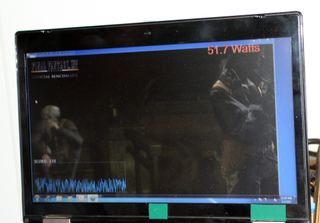CeBIT 2011: AMD Demos Llano Behind Closed Doors
Apparently, Fusion technology demos behind closed doors are becoming an AMD tradition. At this year's CeBIT, the chip maker demoed its upcoming (and highly-anticipated) Llano APU. Naturally, the Tom's Hardware team was on-hand to take a closer look.

AMD Demos Mobile Llano
At its booth at CeBIT 2011, AMD showed off the mobile version of its upcoming Llano APU. But whereas last year’s demo system still looked very improvised (it definitely screamed "engineering sample"), this Llano-based system actually looked like a notebook you might find in a store. It wasn't an attractive notebook, mind you, but it certainly seemed ready to ship, aside from some final design touches.
The company had an explanation for demonstrating its mobile part, rather than the desktop version we'd all probably rather see in action. Similar to the Brazos platform, it intends to launch the new APUs in the mobile space first. As a quick reminder, Llano will be AMD's mainstream APU, combining two to four Phenom-style x86-64 cores and a GPU on one die.
The demo system was running an as yet-unnamed quad-core Llano part with a 1.8 GHz clock, 4 GB of DDR3-1333 memory, Crucial’s C300 SSD, and Windows 7. For comparison, AMD picked an off-the-shelf notebook with identical specs, but built around Intel’s Core i7-2630QM at 2.0 GHz (plus Turbo Boost, obviously). Both systems relied on their respective integrated graphics solutions. AMD's argument there was that Intel is selling its HD Graphics 3000 solution as a mid-range part that can also handle gaming. We would love to show you photos, but we were only allowed to take pictures of the machines’ screens.


There were three parts to the demo. First, AMD wanted to make an image quality comparison, leaving speed out of the equation for a moment. So, AMD’s John Taylor, director of global client product and software marketing, who was running the demo, started up 3DCenter’s Filtering Tester, a tool that shows how anisotropic filtering is handled. While AMD's implementation looked very close to ideal, Intel was obviously taking a performance shortcut by using angle-based optimizations.
Next up was a simple FurMark test to show the two integrated GPUs' rendering performance. Here are the results in table form:
| FurMark Settings | Intel Core i7-2630QM | AMD Llano Quad-Core |
|---|---|---|
| 1024x768, No AAAverage/Minimum/Maximum | 10/9/14 FPS | 16/15/30 FPS |
| 1024x768, 4x AAAverage/Minimum/Maximum | 2/2/2 FPS | 8/7/14 FPS |
| 1024x768, No AA, Displacement Mapping EnabledAverage/Minimum/Maximum | 2/2/3 FPS | 6/5/10 FPS |
The first thing you’ll note is that Intel’s HD Graphics 3000 struggles from the get-go, even at the least-taxing settings. Meanwhile, AMD certainly isn’t generating smooth frame rates. However, its on-die Radeon implementation takes less of a hit than Intel. What you can’t see is that, in the last run, with displacement mapping turned on, the “furry donut” in the middle of the scene failed to render completely on the HD Graphics 3000 engine, meaning that the Intel solution failed this iteration. At this point, John pointed out that not only was Intel taking shortcuts with image quality, but they weren't even helping the performance. Put another way, graphics hardware is only one part of the equation; you also need a fully-functional driver to actually play games.
Stay on the Cutting Edge
Join the experts who read Tom's Hardware for the inside track on enthusiast PC tech news — and have for over 25 years. We'll send breaking news and in-depth reviews of CPUs, GPUs, AI, maker hardware and more straight to your inbox.
-
amk09 APU's are cool especially for cheap mobile gaming but I'm still looking forward to the more powerful CPU's AMD will be offering WITHOUT integrated graphics.Reply -
Cool, me i encode a lot.. so what about ENCODING... with handbrake ?! can't wait to see the results.Reply
gj AMD... i was losing hope but its back now! -
sabot00 Seems to be pretty good, but the price matters dramatically, for a $600-700 laptop this would be very good performance, but if the Phenom cores have not changed much then the clock speed really does need to go up to say 2.4GHz at least, with 2.8GHz+ being more ideal.Reply
For a quad-core 2 GHz will probably be OK, but not that many applications really benefit, and for multitasking AMD will need to pull through with the software.
For the GPU, I would say 200SP's should be the minimum, and from the HD 3000 to Llano comparison I would peg the GPU at that. At 200 SP's it would be very decent for mainstream gaming at lower resolutions, playing most games quite smoothly at low-mid settings. However Llano could take a larger and higher chunk out if it gets a few versions with 300 or 400SP's.
All-in-all, this current 4 core, 1.8GHz, ~200SP version is very respectable and has a lot of potential, but AMD needs marketing, deals with OEMs, and more marketing.
What would I prefer? A 2 core, 2.6Ghz over this CPU, and maybe just a bit more SP's.
Oh! And overclocking support. -
epdark In regards to your guys request for information about how we are using our systems. I am probably a horrible case...Reply
I almost always choose to run games in windowed mode (FFXIV for example) and am often surfing the fan sites, youtube, etc while I am also running the game in the background and quickly switching back and forth. I've also began using Office to write papers at the same time and as well sometimes have a 1080p or 720p movie playing pinned to top while I'm doing so...
So yes, those sort of uses are growing increasingly appealing to me. I find that we don't even realize it sometimes but as the technology allows we are beginning to multitask with it in a natural and almost unconscious manner.
I don't do those things because I know I can and I should. I do those things because I now can and they seem natural progressions for my usage. -
cangelini I'm with you epdark. Even when I'm playing WoW, I'm often looking at YouTube to research upcoming fights and WoWwiki for info on various abilities. You're not a horrible case at all :)Reply
Chris -
bugo30 I sometimes render an animation in Blender, listen to music, have Firefox open on one monitor and a full screen game open on the other. This doesn't work very well on my Athlon X2 4800. I'd be interested to see how it would work on a modern CPU.Reply -
drakefyre What does Quick Sync do for HD vid playback? Shouldn't it almost eliminate processor and graphics workload, or do I misunderstand it?Reply -
joytech22 I normally play RS in resizeable mode while watching youtube video's, RS is very CPU-intensive (Grand Exchange) as well as quite graphics hungry in some areas.Reply
GPU does the rendering (RS graphics and Youtube video processing) while the CPU cores also do rendering for RS, as well as animation processing.
Can be quite taxing on a system, especially my laptop with a Radeon 4530 and a C2D 2.2GHz. -
dmytty Idle power consumption is once again dominated by Intel...why?Reply
My priorities for laptops are such:
1. As light and durable as possible for the given size
2. Good Screen (non-glossy, high resolution, outdoor viewable, high gamut)
3. Long battery life - 8 hrs seems a reasonable compromise
If I'm doing something resource-intensive, I'll sit behind a desktop.
Given that most multi-tasking still results in an idle state most of the time, I can't see how AMD is competitive on point #3 while having double the idle power consumption of Intel.
2x more idle?...AMD is really doing something wrong.
Most Popular


